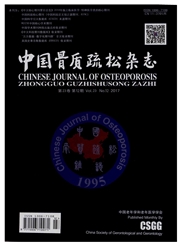

 中文摘要:
中文摘要:
目的了解广西多民族在校大学生体能测试与骨密度含量,并进一步探讨体能测试与骨密度的关系。方法随机抽取广西地区汉族、壮族及其他民族(瑶族、苗族、侗族、土家族、布依族等少数民族)共1084名在校大学生,采用超声骨密度仪测量右跟骨骨密度,包括T值和Z值。体能测试包括男女50米跑、男子1000米跑和女子800米跑的成绩。结果汉族、壮族和其他民族大学生的体能测试(包括短跑时间、短跑分数、长跑时间、长跑分数)和骨密度(T值和Z值)均无统计学差异(P〉0.05);随着短跑速度的增加,T值和Z值呈上升趋势(三者P值均为0.000);随着长跑速度的增加,T值和Z值呈上升趋势(P值分别为0.004、0.000、0.036)。结论广西多民族在校大学生的体能测试和骨密度不因民族不同而有差异;不同强度的体能测试对骨密度的影响不同,在机体承受的范围内,较高强度的体能测试对骨密度的促进作用更大。
 英文摘要:
英文摘要:
Obje ctive To evaluate physical fitness test performance and bone mineral density in multi-ethnic college students in Guangxi,and to explore the relationships between physical fitness test performance and bone mineral density. Me thods A total of1084 college students were randomly selected. These college students coming from Han、Zhuang and other ethnic groups( including Yao,Miao,Dong,Tujia and Buyi). The right calcaneal bone density was measured by quantitate heel ultrasound,and T-score and Z-scores were obtained. Physical fitness tests included men and women 50 meters running,men’s 1000 meters running and women’s 800 meters running. Re sults The physical fitness test performance( including the speed and score for sprint and long distance running) and bone density( T- and Z-scores) of students of Han,Zhuang and other ethnic groups were not statistically significant( P 〉 0. 05). With the increase of sprint speed,T-and Z-scores showed an upward trend( P values were 0. 000). With the increase of long distance running speed,T- and Z-scores showed an upward trend( P values were 0. 004,0. 000,0. 036,respectively).Conclusion Physical fitness test performance and bone mineral density of college students in Guangxi were not significantly different among ethnic groups. The association of physical fitness tests of different intensity with bone density is different. Within the range that the body can bear,the higher the intensity of the physical fitness test,the higher the bone density.
 同期刊论文项目
同期刊论文项目
 同项目期刊论文
同项目期刊论文
 期刊信息
期刊信息
